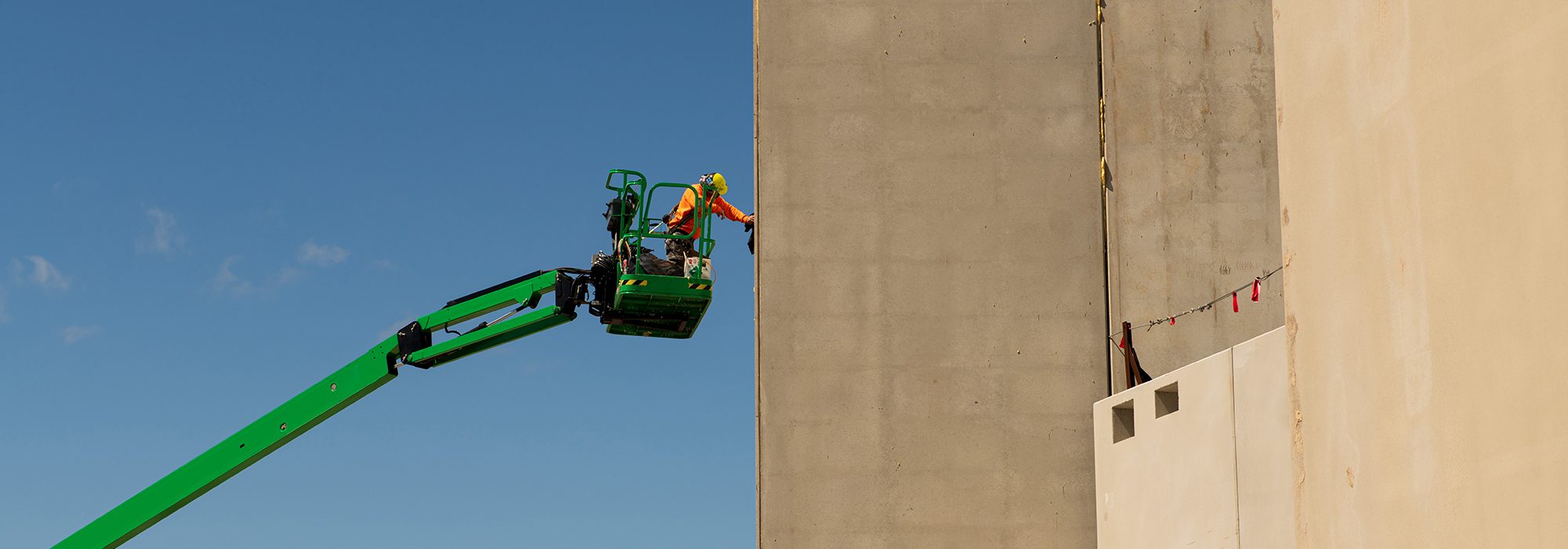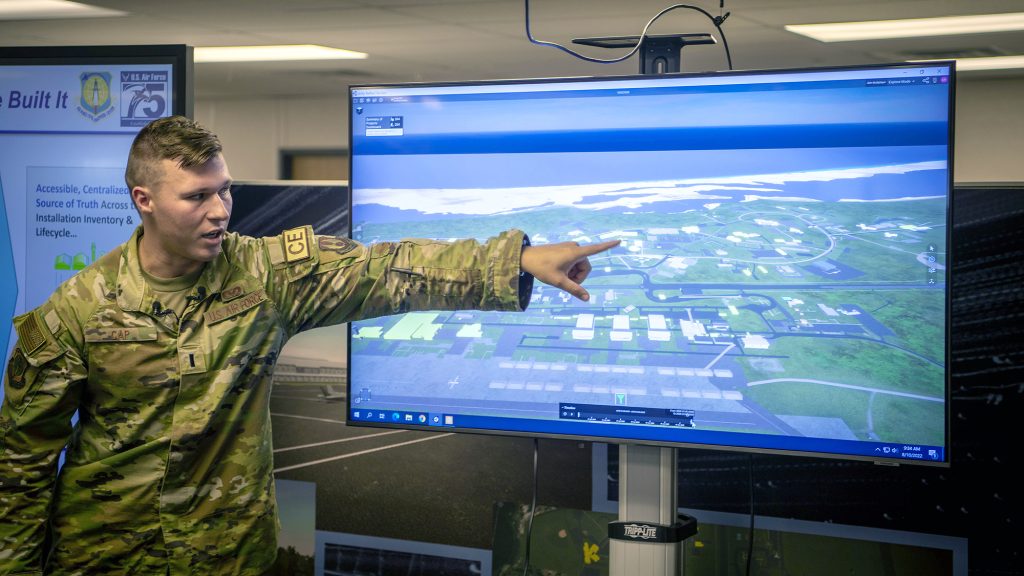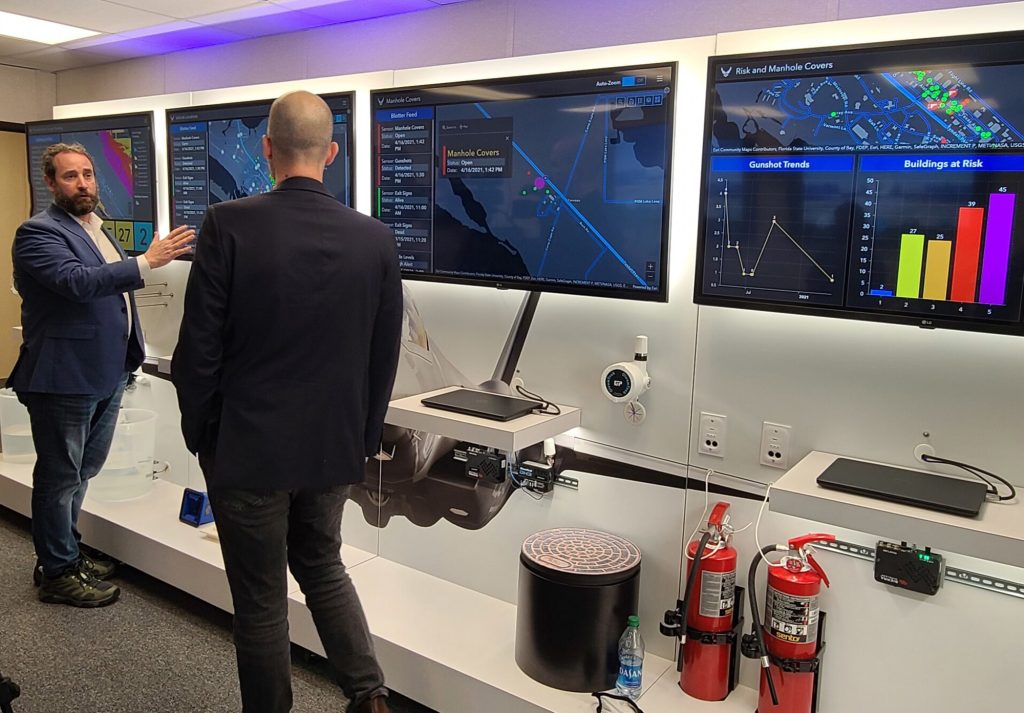How the Air Force is rebuilding the base to withstand future hurricanes.
Tyndall Air Force Base, Fla.—Hurricane Michael tore through this base nearly five years ago, devastating hangars and aircraft and raising some to ask if Tyndall Air Force Base should be given up for good. Instead, Air Force and Florida leaders rallied to the idea that they could build a model “Installation of the Future” here and protect it with a combination of new technology, new understanding, and back-to-the-future ecology.
Today, sand dunes, box culverts, oyster reefs, and new wind-resistant buildings rated to withstand winds up to 165 miles per hour are enabling Tyndall to rise again. The Air Force is pouring some $5 billion into this strategically located base, which affords direct access to one of the nation’s largest and most versatile air training ranges. New F-35A Lightning II fighters have begun arriving, ready to make use of those training ranges and will eventually dominate this fighter base.
With weather getting more unpredictable and threatening coastal areas all around the globe, Tyndall is applying both time-proven and novel means to protect the base, its residents, and its mission. Restored sand dunes here will absorb the brunt of ocean waves during a hurricane. Piled atop 18 miles of barrier islands surrounding Tyndall, they make up the base’s “first line of defense for storms,” said Melanie Kaeser, a biologist with the U.S. Fish & Wildlife Service.
Col. Robert Bartlow Jr., chief of the Air Force Civil Engineer Center Natural Disaster Recovery DivisionIt’s not ‘wind blows and things just fall over’. … Those high-velocity winds cause rapid pressure changes inside the facility, and it will start to come apart.
Hurricane Michael swept over dunes and wiped out much of the vegetation on the barrier islands, disrupting the habitat and opening the way for further damage in the future. Kaeser’s team is restoring those barrier islands, planting grasses and shrubs with an eye on learning which prove best at trapping sand. Kaeser said the dunes are already recovering without intervention, but her team’s work is to “speed that process up.”
“If you don’t build it back up, you’re going to keep pushing back that first line of defense,” she explained. “That’s what took the brunt of the storm surge, so without these barrier islands, that storm surge would have gone right on to the installation.”
Kaeser’s team is also restoring thousands of acres of pine forests around the base to help block severe winds. Planting longleaf pines, which can resist wind, insects, and disease better than the slash pines that were here before should prove effective over time. The team has planted 6.5 million of the fast-growing seedlings in the past three years and aims to plant another million within the next year.
Elsewhere on Tyndall, scientists are deploying biodegradable concrete and cement to provide a foundation for seagrass and oysters, a technology called Reefense. Once at home here, the oysters can build and repair wave-blocking reefs on their own, according to Rutgers University, which received $12.6 million from the Defense Advanced Research Projects Agency to pursue the technology.
Living shorelines, a combination of plants, rock, and sand designed to attract marine life; oyster reef breakwaters; and expanded salt marshes are other ways Tyndall officials hope to dissipate waves and reduce flooding, according to installation documents and The Nature Conservancy, which is contributing to developing Tyndall’s natural defenses.
“The focus of everything is slowing down that wave attenuation as it comes on shore, whether it’s natural waves, tidal surges, or hurricane-related events,” said Garey Payne, acquisition program manager with the Air Force’s Natural Disaster Recovery Division. “You have this overlapping field of effect that eventually makes the installation more robust to the effects of climate change, sea-level rise, and natural erosive processes.”
MacDill Air Force Base, Fla., has been working on oyster reef shoreline stabilization since at least 2004. But what’s new at Tyndall is a funding mechanism to facilitate such projects. In the wake of the hurricane damage, Congress expanded the Readiness and Environmental Protection Integration (REPI) program in 2019, allowing the military to use federal funding for installation resilience projects, even if those projects are outside of a base’s land or water boundaries.
That means Tyndall can use federal funding to experiment with oyster breakwaters in Florida state waters beyond the base’s shoreline. That funding can help attract state and local government or conservation agencies to work with the Air Force on such projects.
“Prior to REPI funds being available for this kind of work, it took community partnerships, it took convincing the county or state or whoever to spend their money to do a living shoreline,” Payne said. “Now we’re bringing the money to them: we need you to do the legwork because it’s in state waters, but we are going to give you the money to do it.”
Wind Resistance
Tyndall is also investing heavily in base infrastructure. After Hurricane Michael, Air Force engineers raised the bar for building standards here, matching what they saw in Florida’s Miami-Dade County. Each new building at Tyndall is built to survive 165-mile-per-hour winds. And they’re adapting those standards to match the Air Force’s special needs.
“A lot of what’s down in Miami is commercial properties,” said William Heiney, senior resident engineer for the Tyndall office of the U.S. Army Corps of Engineers, which oversees the day-to-day awarding of contracts and site management on the base. “We’re going to have some unique building elements. … “If they don’t have an existing system that we can use, then [the building element] is designed, engineered, and stamped by a structural engineer to meet those requirements,” he said.
To meet the 165-mile-per-hour standard, some foundations must be sunk 30 to 40 feet deep. Precast structures are common. And the volume of rebar in concrete walls, screws and other fasteners used to secure roofing materials, is increased. The key is to keep wind from penetrating, either by peeling doors open or shattering windows to cause explosive imbalances in air pressure.
“It’s not ‘wind blows and things just fall over,’” said Col. Robert L. Bartlow Jr., chief of the Natural Disaster Recovery Division. “If your building envelope is compromised, those high-velocity winds cause rapid pressure changes inside that facility, and it will start to come apart.”
All Dry on the Flight line
To keep the flight line flood-free, Tyndall is building a massive underground concrete tunnel, 7 feet high and 12 feet wide in some sections, stretching across the area known as Zone 1, where the F-35 hangars will be located. Called a box culvert, the tunnel will funnel stormwater away from the flight line and back toward the ocean.
Buildings on the base will be constructed on a gradual incline, raising them above flood levels and sea-level rise.
Even now, five years after the hurricane, the project is still years from completion. Rebuilding Tyndall is not expected to finish until 2027, and some of the natural storm resilience projects may take even longer.
But once complete, the aim is to ensure Mother Nature will not be able to take U.S. airpower offline for long.
“We’re not going to treat a Category 5 storm as an exceptional event,” Bartlow said. “That’s the new standard.”
NEW TECHNOLOGY
Base planners here are evaluating a suite of new technologies that could change the way military installations operate well into the future.
Among them is a concept already familiar to Air Force weapons programs—a Digital Twin model of the base in which each building is represented by 3D virtual replica. Planners believe the model can save time and money by helping them to predict wear and tear on facilities and to manage a basewide, comprehensive plan for maintenance.
“If we’re going to build the “Installation of the Future,” we need to figure out what’s new out there that we can use to make us more effective at operating,” said Col. Robert Bartlow Jr., chief of the Air Force Civil Engineer Center Natural Disaster Recovery Division.
Lance Marrano, science and technology adviser for reconstruction at Tyndall, said models like these can help managers anticipate problems, rather than be surprised by them.
“Instead of waiting for the occupants to say, ‘Hey, I’ve got water on my floor,’ now the engineer can look across the base, get a better sense of which roofs are approaching end of life, and then you start developing those engineering projects rather than waiting for a work ticket and more damage,” he said.
Marrano comes to Tyndall from the U.S. Army Corps of Engineers, which hopes to learn from Tyndall’s example and possibly apply the same technology to Army bases. He explained that the digital twin enables a kind of X-ray vision for engineers or facility managers, who can, for example, hold an iPad up toward a ceiling and use the virtual model to detect exactly which ceiling tile they need to move to access a water pipe.
Installation of the Future
These new technologies form just one pillar of the ongoing $5 billion reconstruction project at Tyndall, which was destroyed by Hurricane Michael in 2018. New facilities and a new F-35A Lightning II fighter wing will also shape Tyndall’s effort to become an ‘Installation of the Future,’ a model for how the Air Force writ large might become safer, stronger, and more efficient in the years ahead.
There are still more emerging technologies that could further enhance security at Tyndall:
ZeroEyes: An artificial intelligence program that scans more than 60 live security camera feeds and alerts Security Forces if a firearm is detected. Rapid detection should help defenders prepare and respond faster in case of an active-shooter situation, Tyndall’s Security Force Program Manager Mark Shackley said. Tyndall is the first Department of Defense installation to get ZeroEyes.
Digital Force Technologies’ Force Protection Kit: A system of infrared cameras, ground-based radar, and laser-range finders that artificial intelligence can scan for threats such as unmanned aerial systems. The automated system is supposed to reduce the cognitive load for security forces Airmen, according to the Air Force.
Robot Dogs: Designed by Ghost Robotics, the semi-autonomous quadrupeds sport nine sensors and act as extra eyes and ears both day-to-day and in extreme temperatures, according to the Air Force.
The models are helpful even before the buildings are completed. The director of Tyndall’s soon-to-be-completed child development center did a virtual walk-through of her building and identified areas where toddlers might hide, Marrano said; nurses also got a preview of their spaces.
“Anybody from the base can come in and interact with their facility,” he said. “Being able to help users look at their facilities before they receive them and give feedback is really important.”
The models are helpful in storm planning. The base model lets managers anticipate how storm surges could affect the base, model traffic congestion due to construction, and simulate the effects of a major exercise, like Checkered Flag. Security Forces Airmen can use it to model how they might respond to an active-shooter scenario, knowing that important details, such as which way a door swings open, are faithfully rendered.
The digital twin project is in a pilot stage as the base awaits cyber accreditation, Marrano said, but the program should be ready for wider use in about six to nine months. At that point, the concept could be applied to other bases—provided facility data is available at those facilities. Over the next year, Marranos’ team will explore how to align data standards so that installation managers across the military can quickly create digital twins of their own bases.
IROC n’ Roll
Another new concept getting a test-run at Tyndall is its Installation Resilience Operations Center (IROC). Here, base leadership, first responders, facility managers, and others gain a common operating picture of the facility in real time.
The IROC aims to answer the question: “How do we take all these different hardware and sensors and connect them up to the decision-makers?” Marrano said. “If every piece of information is in a silo and a human is all that’s gluing it together, then that slows down our decision-making process and introduces errors.”
Conventional processes require time for information to be relayed from one strata to the next. For example, if a fire starts on the flight line, a fire marshal establishes a safety cordon and radios security forces, who map out the incident on a whiteboard with a marker, then relay that information to the unit command center, Marrano explained. But each stage of voice-to-voice communication adds time and increases the risk that information will be relayed incorrectly.
“Grid coordinates or other numbers get switched around all the time,” said Mark Shackley, innovation team lead and security force program manager for the Natural Disaster Recovery Division. “Your entry control point might end up somewhere else. Being able to take that data, make it digital, and show the same across everyone’s devices means nobody’s getting lost.”
Day-to-day, IROC can pull in data from building sensors to alert facility managers if air conditioners are not working properly, if a leak is detected, if humidity is reaching unusual levels, or if doors are not closing properly. Consolidating all that data into a single system simplifies everything, especially as systems and sensors are increasingly networked into a base’s “Internet of Things.”
“If you went to the fire station or the base defense operations center, you’ll see an Airman watching five or six monitors with three or four keyboards in front of them,” said Marrano. “You can’t respond effectively with that much information overload.”
The same concept scales across the entire Department of the Air Force. In the future, base IROCs could feed data to an enterprise-level operations center. If a vulnerability or inefficiency is detected in one IROC, enterprise analysts could help resolve similar issues at other bases.
To keep IROC cybersecure, each facility at Tyndall will have its own network switch and gateway, so that a vulnerability can be contained, and not allowed to spread to the rest of the base, Marrano explained.
The IROC already links more than 60 buildings at Tyndall, and USAF leaders are looking at which installation might be next.
“Within a [fiscal] quarter or so, we’re going to have more examples of how that data gets connected together, more information fused and layered together to provide more insights,” Marrano noted.
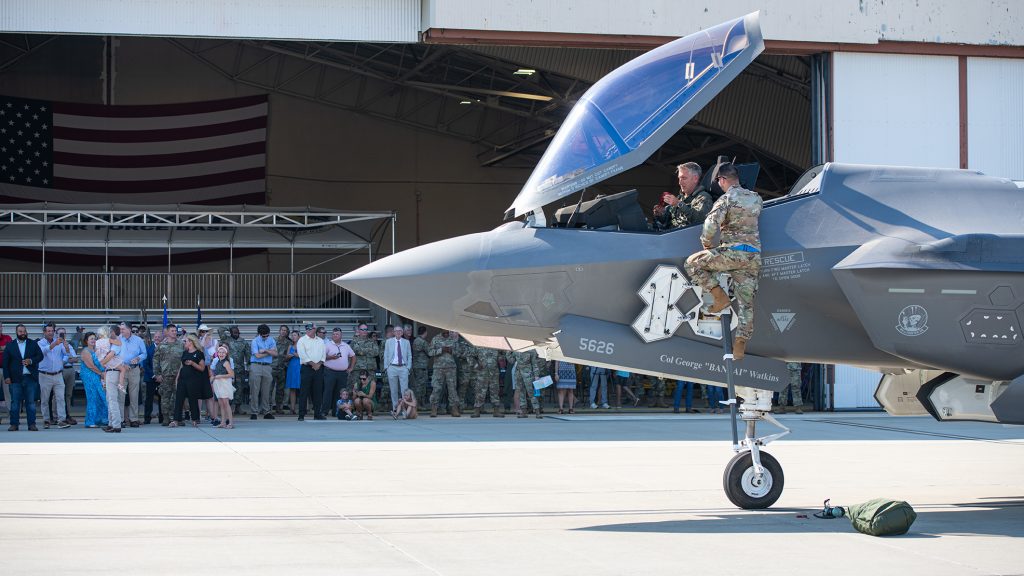
Tyndall Air Force Base Will Be an F-35 Maintainer’s Dream … Eventually
Three new hangars under construction at Tyndall Air Force Base, Fla., could make maintaining the F-35 Lightning II, the world’s most advanced fighter jet, more efficient than ever, with built-in maintenance facilities, a walkable campus, enhanced wireless connectivity, and other amenities.
“This is a dream for any maintainer,” said Col. Robert Kongaika, commander of the 325th Maintenance Group, which will oversee the upkeep of the 78 F-35s to be assigned to Tyndall’s 325th Fighter Wing.
The base is undergoing a $5 billion reconstruction effort after Hurricane Michael destroyed it in 2018. As the installation transitions from training F-22 students to flying operational F-35s, it is also building new facilities and new technological capabilities as it strives to become the Air Force’s ‘Installation of the Future,’ the model of what the service could look like in years to come.
The three F-35 hangars, one for each squadron, are a part of Tyndall’s Zone One, an area devoted to flight line activities. The zone includes a maintenance complex, group headquarters, aircraft parking aprons, aircraft support equipment storage, a corrosion control facility, and an F-35A flight simulator building. It is the single largest military construction contract on record in the Air Force database, which dates back to 2008, according to an Air Force release. The construction contract is $532 million, but contingencies and contract oversight brings the total investment to $604 million.
The top-dollar price should deliver top-of-the-line quality: each hangar will serve as home for both maintainers and pilots for each of the three F-35 squadrons, which should allow for easy cross-pollination, Kongaika explained. Hangar doors at either end of the facilities will let jets flow in and out more easily, he said.
Maintenance demands ample electricity to power the aircraft; air for inflating tires or environmental control systems; and water for spraying down the jets. In older hangars, maintainers would bring in noisy aerospace ground equipment that guzzled fuel and generated exhaust, but at Tyndall those utilities will come straight out of the building itself. The colonel worked with a similar set-up at Luke Air Force Base, Ariz., another F-35 location, where utilities rose up from the hangar floor on hydraulics.
“That’s state-of-the-art in my opinion, because you’re reducing your thrash: the wasted time it takes to bring in other equipment and take it out,” he said.
Air conditioning and high-speed wireless internet will be built-in rather than ad hoc, as is the case in some other facilities. Reliable Wi-Fi is increasingly important to connect tablets and other devices maintainers rely on to fix F-35s. Kongaika envisioned future wrench-turners using augmented reality-equipped headsets or glasses to further streamline the maintenance process.
The challenge is that the hangars will not be built until 2026, but F-35s with the 95th Fighter Squadron have already begun arriving at Tyndall. The first four arrived earlier in August, with 12 more scheduled by the end of summer 2024. For now, maintainers with the 95th Fighter Generation Squadron (FGS) work out of a refurbished office space, but the jets remain outside without the benefit of sunshades.
“We’ve got ice machines, we’ve got Gatorade to try and make that as tolerable as possible, but they will be straight up on the open ramp in the Florida sun,” said Maj. Benjamin Flores, commander of the 95th FGS. “That will be something we’ll have to keep a focus on and try to make it as easy as possible for them.”
Another challenge is the scale of the rebuilding effort, where up to 4,000 construction workers a day rub elbows with operational Airmen. The tight quarters require careful coordination between the 325th Fighter Wing, the Air Force’s Natural Disaster Recovery Division, the U.S. Army Corps of Engineers, and the contractors the corps manages.
“We spend a lot of time trying to look forward to identify where those conflicts could occur and mitigate them before they become an issue,” said Col. Robert Bartlow Jr., chief of the Natural Disaster Recovery Division, “but things happen all the time where we realize we’ve got a problem and we need to address it.”
For example, one of the tenant units at Tyndall is the 601st Air and Space Operations Center, which plans, directs, and assesses air and space operations over North America, a vital mission that cannot be interrupted. But over the next few months, Tyndall is renovating all the utilities across the base, which will require shutting down the roads leading to the 601st building, known as the Air Operations Center (AOC).
“Right now we’re figuring out alternate means of access to the AOC and we’ll come up with one, get it approved, and we’ll press forward,” Bartlow said. “That’s one thing that fortunately we identified well enough in advance.”
Kongaika expressed concern for his Airmen’s safety amid the congestion and construction.
“We have to have a really heightened sense of situational awareness around us, so I’m always preaching safety,” he said. “I want to empower our Airmen to knock it off or slow it down whenever they see things that are the three Ds: dumb, dangerous, or different.”
Maintainers with the 95th FGS are adapting to the fluid circumstances. Their main depot for tools and spare parts is about a mile away and across a security checkpoint from their temporary facility, which can disrupt workflow. To get around the problem, the 95th set up a smaller warehouse in a side room of their current building, reducing the number of back-and-forth trips.
Sustaining a fighter squadron requires thousands of spare parts and equipment such as rolling tool boxes, torque wrenches, screw drivers, pliers, engine covers, safety gear, latex gloves, and more. Col. George Watkins, the commander of the 325th Fighter Wing, likened it to “standing up a super-sized AutoZone.”
But a successful fighter generation squadron also requires the right culture to sustain mission-ready aircraft every day, even in difficult weather. While finding experienced F-35 maintainers is not as difficult today as it was a few years ago when the jet was brand-new, it will take time for the 95th FGS to learn how to work as a team.
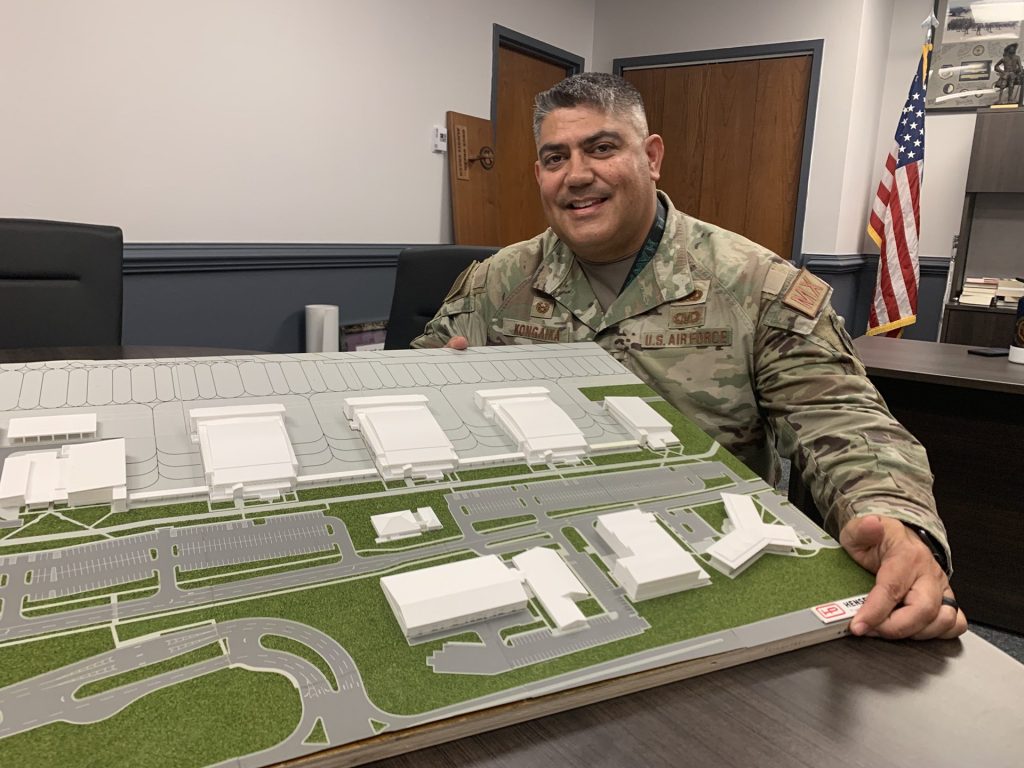
“We have not worked as a team to generate aircraft—we’ve all done it individually at different places,” Flores said. “We have to make sure we have the communication in place and the expectations set so we make the right call and follow the right processes. We’ll learn, but I think that’s just part of the growing process for a new team.”
Kongaika expressed a similar view.
“There’s nothing that replaces hands-on training, so we need some aircraft in order to train,” he said.
The arrival of the first four F-35s should keep maintainers busy for now, as will the dozen coming over the next year. Barring further production delays, the 95th Fighter Squadron should reach full operational capability with 24 primary assigned aircraft and two more in reserve by the middle of 2025. The number of 95th FGS maintainers will also grow from about 50 people on the ground today to an end-strength of 200. Becoming operational will take sweat and coordination, but the new aircraft, the new hangars, and the chance to build a new unit from the ground up has its rewards too.
“Seeing our own aircraft in front of the squadron with the Tyndall tail flash on it … it’s just a good feeling, and I think that’s what everyone is excited about,” said Flores.
